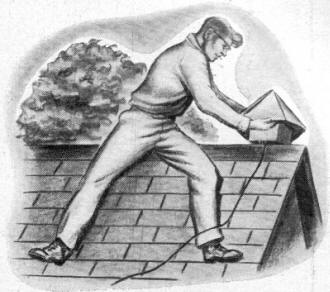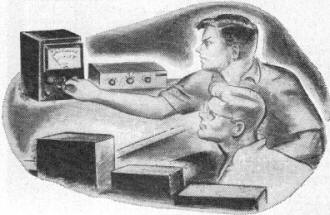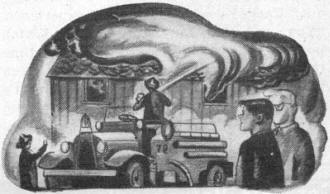March 1960 Popular Electronics
 Table
of Contents Table
of Contents
Wax nostalgic about and learn from the history of early electronics. See articles
from
Popular Electronics,
published October 1954 - April 1985. All copyrights are hereby acknowledged.
|
That John T. Frye
was a great short story writer is evidenced by his decades-long production
of the "Carl & Jerry" series in Popular Electronics, and "Mac's
Radio Service Shop" series in Radio & Television News and
Electronics-World magazines. Mr. Frye also wrote many other short
tech-oriented stories. It is easy
to look over the fact that he also had artistic skills as well as evidenced by the
pencil drawings that accompanied each installment. In this episode, our two
teenaged electronics
hobbyists build a resistor anemometer to measure wind speed from within their basement
workshop. In the usually storyline style, one boy gives a lesson in circuit design
while the other (also the reader) is the attentive student.
Carl & Jerry: A Hot Idea
 By John T Frye By John T Frye
W9EGV
The buffeting March wind spanked Carl with the slamming basement door as he stepped
into the electronic laboratory of his friend, Jerry: The latter was sitting with
his head encased in a pair of muff-type earphones connected to an amplifier with
a variable frequency audio oscillator working into its input. As Carl looked at
his chum aimlessly adjusting the frequency of the oscillator and the gain of the
amplifier, he decided there was something about Jerry's appearance that was not
right. There was a certain lackluster look about his eyes, and his round face looked
fatter than ever - but in a sort of lopsided way.
"Guess I'm the one guy in ten for whom it won't work," Jerry said with a lugubrious
sigh as he shut off the equipment and removed the earphones.
"What won't work, and what's the matter with your face? It looks twice as big
as it ought to."
"The 'audio anesthetic' won't work for me. I've got an infected wisdom tooth
that's killing me, and I have an appointment with the dentist in an hour. But the
other day I read that a Boston dentist discovered that music or random noise put
into earphones worn by a patient killed the pain of dental work in 90% of 2000 cases
tested. The patient adjusts the sound level with a gain control in his lap until
the sound blocks out the pain sensation. A company in Rochester is already in production
on the device. I was trying to see if I could kill the pain of my toothache with
various frequencies from the audio generator, but I couldn't."

"That thing must work on a variation of the 'mule skinner' principle," Carl said.
"You know a veteran mule skinner always took the ear of a mean mule between his
teeth and bit down hard while he was putting on the bridle. The idea was that while
the mule was thinking about how much his ear hurt he couldn't think about kicking
or biting the mule skinner. With the audio anesthetic, while the mind is concentrating
on the sound it ignores the pain. Your trouble is that in fooling around with ham
radio, etc., you've trained yourself to be a little smarter than the mule. You can
listen and still be thinking about your aching tooth at the same time. Well, I better
scram and let you go to the dentist."
"Oh, no, you don't!" Jerry exclaimed.
"I've a little chore for you to perform while I'm gone; and I just know you wouldn't
refuse your poor, pain-wracked buddy."
"Depends on what my poor, pain-wracked, scheming buddy has in mind."
"All I want you to do is mount this thermistor anemometer out on the garage and
run this cable from it back into the lab."
"You know," Carl said thoughtfully, "I don't think you've got a toothache at
all. You've just dislocated your jaw on one of those big words you're so fond of.
What the heck is a 'Mistermometer'?"
"I said a 'thermistor anemometer.' As you know, or should know, an anemometer
is a device for, measuring wind velocity. This one is intended to do so by the use
of thermistors. A 'thermistor' is a resistor whose resistance changes, in a nonlinear
fashion, incidentally, with a change in temperature. The temperature affecting the
resistance may arise externally or it may come from current flowing through the
thermistor. In the case of these thermistors you see on the bench, an increase from
-60 to plus 150 degrees centigrade will cause the resistance to fall from about
2000 ohms to one ohm."
"That sounds dandy for measuring temperature, but I don't see how they can be
used to measure wind velocity."

"Keep listening and you will."
"I've arranged two matched thermistors and two resistors - one variable - in
a bridge circuit," Jerry explained as he sketched the familiar diamond-shaped bridge
circuit. "These two top legs are the thermistors; the two bottom legs are the resistors.
Here's a battery in series with a switch connected between the common junction of
the two thermistors up here and the common junction of the two resistors at the
bottom. A d.c. meter connects from this left-hand thermistor-resistor junction across
to the right-hand thermistor-resistor junction.
"Now, when the variable resistor is properly adjusted to equal the fixed resistor,
the battery current divides equally between the left and right sides of the bridge.
Since the same current flows through each thermistor, any resistance change in one
is duplicated by the resistance change in the other, and the bridge stays in balance.
Voltage drop along the two sides is identical, and no current flows through the
meter."
"How do you know the thermistors in your bridge are matched?"
"Because I matched 'em. I put the bridge in the freezer where the temperature
is below zero and then put it in that light-bulb-heated oven and brought the temperature
up to 150 degrees. I kept repeating this test with different combinations of thermistors
until I found two that would go through the temperature swing with practically no
indication of current through the meter at any point. You satisfied?"
"Yep, but how does the thing measure wind velocity?"
"As you can see, one thermistor is mounted inside this aluminum can with tiny
holes in the top and bottom to permit outside air to filter very slowly through.
The other thermistor is mounted out in the open so wind can blow around it freely.
When battery current flows through both thermistors, heating them, the heat is lost
to the surrounding air. In a dead calm, the heat lost by the enclosed thermistor
and the heat lost by the one outside in absolutely still air will be the same and
no reading will show on the meter.
"However, when a wind is blowing, the heat from the exposed thermistor will be
carried away; the harder the wind blows, the faster heat is lost. Heat lost by the
enclosed thermistor in its artificial calm will remain the same. The wind-cooled
thermistor will stay high in resistance while its hotter buddy inside the can will
go lower in resistance,. unbalancing the bridge and permitting current to flow through
the meter. All we have to do is to calibrate this current-indicating meter in terms
of wind miles per hour and we have a remote-indicating anemometer with no moving
parts."

"I suppose. this little wooden umbrella-shaped canopy is to keep the sun and
rain from influencing the reading."
"Right. Actually the whole thing is pretty crude, but I want to put it up for
a while and see how much rain and sun does affect it. This variable March weather
is ideal for making such a study. Will you put it up?"
"Oh, I reckon," Carl said gruffly. "Quit stalling and get to the doctor."
Actually Carl was as eager as his friend to tryout the new gadget, and he lost
no time after Jerry had gone. It took but a few moments to fasten the device securely
to the garage gable and to run the four-wire TV antenna rotor cable back into the
basement through a casement window. There he connected two of the wires to the battery-and-switch
combination, and the other two were connected to the milliammeter. When the switch
was thrown, the meter indicated up-scale; and Carl was fascinated by the way the
meter reading kept step with the roar of the March wind outside. He was still watching
the meter when Jerry came in the door.
"You're still kind of fat in the face," Carl remarked critically, "but you look
better. Could he save the tooth?"
"He can if he wants to; I left it with him," Jerry replied breezily. "He yanked
it out, and it didn't hurt a bit."
"Just wait until that dope starts dying out," Carl said with the voice of experience.
"Your gadget is working fine, Jer. Watch how the meter pointer moves up every time
the wind bends the tops of those trees through the window there - hey, that's funny,"
he broke off. "It was working swell, but look at the crazy way it's behaving now."
The meter was acting strangely. No longer did the pointer keep step with the
roar of the wind. First it bobbed up and down the scale erratically and then began
backing off scale below zero. Finally it settled firmly against the left-hand stop
and refused to budge until Carl opened the switch; then it came to rest on zero.
"Something's gone wrong out there. You stay here and watch the meter while I
go have a look," Carl suggested.
He had hardly reached the top of the outside basement stairs when he began shouting;
"Call the fire department! Call the fire department! Kreuger's barn across the alley
is on fire, and is it ever going!"

Jerry rushed upstairs and called the fire department, and then he ran out in
the back yard. By this time the old two-story frame barn across the alley was a
mass of flames; and blazing shingles were sailing all around. Long tongues of flame
reached across and licked at Jerry's garage.
The fire department came roaring up and started playing water on the burning
barn and the other buildings nearby, but the fire was not put under control until
it had burned the high tension wires overhead in two.
"Boys, that was close," the fire chief said to Carl and Jerry. "If the thing
had had ten minutes more start with this wind, that whole row of garages could easily
have gone. It certainly is a good thing you spotted it when you did. How did you
happen to see it?"
"Well, we were kind of tipped off by a sort of fire detector we had installed
on our garage roof," Jerry explained lamely. He knew from bitter experience the
difficulty of trying to describe the working of electronic equipment to people without
an electronic background.
"Actually it's not hard to figure what happened," he said to Carl after the chief
had gone and the two boys were walking back to their laboratory. "The wind was blowing
right from the fire toward our garage. When a tongue of flame would lick over and
slu-u-urp that exposed thermistor, the can would protect the enclosed thermistor
from the quick increase in temperature. As a result, the exposed thermistor got
hotter than the enclosed one, and this made the meter read backward."
Jer, old buddy," Carl said as he laid an affectionate arm across his friend's
shoulders, "the thing I like about you as an inventor is that you always invent
something. Of course, you may set out to invent a thermistor anemometer and end
up with a jim-dandy fire detector; but, by golly, you come up with something! Man,
you're the most!"
"Thanks, pal - I think!" Jerry answered as he grinned crookedly up with his still
swollen face at his friend.
|
Carl Anderson and Jerry Bishop were two teenage boys whose
love of electronics, Ham radio, and all things technical afforded them ample opportunities
to satisfy their own curiosities, assist law enforcement and neighbors with solving
problems, and impressing – and sometimes toying with - friends based on their proclivity
for serious undertakings as well as fun.
- See Full List -
 Carl & Jerry, by John T. Frye Carl & Jerry, by John T. Frye
Carl and Jerry Frye were fictional characters in a series of short stories that
were published in Popular Electronics magazine from the late 1950s to the early
1970s. The stories were written by John T. Frye, who used the pseudonym "John T.
Carroll," and they followed the adventures of two teenage boys, Carl Anderson and
Jerry Bishop, who were interested in electronics and amateur radio.
In each story, Carl and Jerry would encounter a problem or challenge related
to electronics, and they would use their knowledge and ingenuity to solve it. The
stories were notable for their accurate descriptions of electronic circuits and
devices, and they were popular with both amateur radio enthusiasts and young people
interested in science and technology.
The Carl and Jerry stories were also notable for their emphasis on safety and
responsible behavior when working with electronics. Each story included a cautionary
note reminding readers to follow proper procedures and safety guidelines when handling
electronic equipment.
Although the Carl and Jerry stories were fictional, they were based on the experiences
of the author and his own sons, who were also interested in electronics and amateur
radio. The stories continue to be popular among amateur radio enthusiasts and electronics
hobbyists, and they are considered an important part of the history of electronics
and technology education.
|
-
Lie Detector Tells All - November 1955
-
The
Educated Nursing - April 1964
- Going Up
- March 1955
-
Electrical
Shock - September 1955
- A Low Blow
- March 1961
- The Black
Beast - May 1960
- Vox
Electronik, September 1958
- Pi in
the Sky and Big Twist, February 1964
-
The
Bell Bull Session, December 1961
- Cow-Cow
Boogie, August 1958
- TV Picture,
June 1955
- Electronic
Eraser, August 1962
- Electronic
Trap, March 1956
- Geniuses
at Work, June 1956
- Eeeeelectricity!,
November 1956
- Anchors
Aweigh, July 1956
- Bosco
Has His Day, August 1956
- The Hand
of Selene, November 1960
- Feedback,
May 1956
- Abetting
or Not?, October 1956
-
Electronic Beach Buggy, September 1956
-
Extra Sensory Perception, December 1956
- Trapped
in a Chimney, January 1956
- Command
Performance, November 1958
- Treachery
of Judas, July 1961
- The Sucker,
May 1963
-
Stereotaped
New Year, January 1963
- The
Snow Machine, December 1960
-
Extracurricular Education, July 1963
-
Slow Motion for Quick Action, April 1963
- Sonar
Sleuthing, August 1963
- TV Antennas,
August 1955
- Succoring
a Soroban, March 1963
- "All's
Fair --", September 1963
-
Operation
Worm Warming, May 1961
|
-
The Electronic Bloodhound - November 1964
-
Great Bank Robbery or "Heroes All" - October 1955
-
Operation Startled Starling - January 1955
- A Light
Subject - November 1954
- Dog
Teaches Boy - February 1959
- Too Lucky
- August 1961
- Joking
and Jeopardy - December 1963
-
Santa's Little Helpers - December 1955
- Two
Tough Customers - June 1960
-
Transistor
Pocket Radio, TV Receivers
and
Yagi Antennas, May 1955
- Tunnel
Stomping, March 1962
- The Blubber
Banisher, July 1959
- The Sparkling
Light, May 1962
-
Pure
Research Rewarded, June 1962
- A Hot Idea, March
1960
- The Hot Dog
Case, December 1954
- A
New Company is Launched, October 1956
- Under
the Mistletoe, December 1958
- Electronic
Eraser, August 1962
- "BBI", May 1959
-
Ultrasonic
Sound Waves, July 1955
- The River
Sniffer, July 1962
- Ham Radio,
April 1955
- El
Torero Electronico, April 1960
- Wired
Wireless, January 1962
-
Electronic Shadow, September 1957
- Elementary
Induction, June 1963
- He Went
That-a-Way, March1959
- Electronic
Detective, February 1958
- Aiding
an Instinct, December 1962
- Two Detectors,
February 1955
-
Tussle
with a Tachometer, July 1960
- Therry
and the Pirates, April 1961
-
The Crazy Clock Caper, October 1960
|
 Carl & Jerry: Their Complete Adventures is
now available. "From 1954 through 1964, Popular Electronics published 119 adventures
of Carl Anderson and Jerry Bishop, two teen boys with a passion for electronics
and a knack for getting into and out of trouble with haywire lash-ups built in Jerry's
basement. Better still, the boys explained how it all worked, and in doing so, launched
countless young people into careers in science and technology. Now, for the first
time ever, the full run of Carl and Jerry yarns by John T. Frye are available again,
in five authorized anthologies that include the full text and all illustrations." Carl & Jerry: Their Complete Adventures is
now available. "From 1954 through 1964, Popular Electronics published 119 adventures
of Carl Anderson and Jerry Bishop, two teen boys with a passion for electronics
and a knack for getting into and out of trouble with haywire lash-ups built in Jerry's
basement. Better still, the boys explained how it all worked, and in doing so, launched
countless young people into careers in science and technology. Now, for the first
time ever, the full run of Carl and Jerry yarns by John T. Frye are available again,
in five authorized anthologies that include the full text and all illustrations." |
Posted June 15, 2021
(updated from original post on 5/29/2014)
|









 By John T Frye
By John T Frye




 Carl & Jerry, by John T. Frye
Carl & Jerry, by John T. Frye
